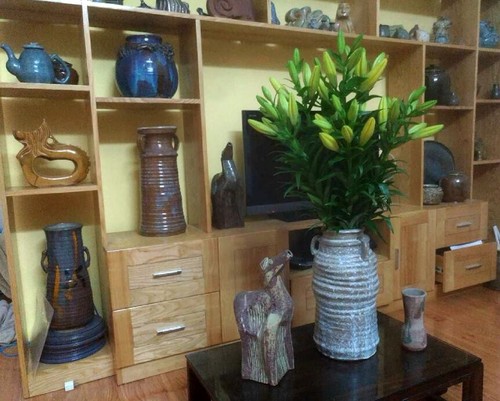
Chi ceramic products (Photo credited by Gom Chi)
|
Soon after, I decided to organize a weekend ceramic workshop for my sons and his friends to teach them how to throw and shape clay on a wheel. Following the workshop, I rode 13km to the Chi Ceramics Workshop in Yên Viên town, in Hanoi’s outlying Gia Lâm district, to learn more about their ceramics.
Nguyễn Hồng Tân, the second son of Mr. Chi, the founder of Chi Ceramics, received me in a quiet, simple workshop where ceramic materials and items lay about.
Tan told me that his family has been in the business for over 100 years and the family business was originally located in Bát Tràng village.
“Chi ceramics and their specific features have been defined since the founding. We are the successors of Mr. Chi but have added younger generations’ ways of thinking to the process. So our products have evolved a bit,” said Tân, adding “Generally speaking, designs, patterns, and the ways of creating glaze, colors, and decorations remain the same. This has made our products stand out.”
Tân said Chi ceramic products are not especially splendid or colorful, but they impress customers with their fine glazes and unusual, naturalistic designs.
He explained: “Today the beauty of Chi ceramics has been combined with graphics and sculpture and most of our items, even the most basic products like dinnerware and teapots, have been created manually. That’s the key point. Sometimes moulds are used at certain stages to produce products more quickly.”
Chi ceramics, in fact, have had a well-established reputation, particularly in fine art circles, for a long time. They are famous for improvised, and therefore unstandardized, products with naturally varying glazes and simple but stylized decorative patterns.
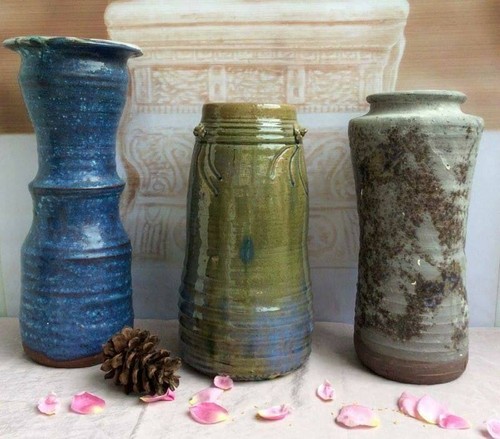 A stylized Chi ceramic vase with a tall body, wide mouth, well-proportioned waist, and simple patterns. (Photo credited by Gom Chi) A stylized Chi ceramic vase with a tall body, wide mouth, well-proportioned waist, and simple patterns. (Photo credited by Gom Chi) |
“Each of our products is different because it’s made by a different artist, my brothers and I. This difference creates the variety of Chi ceramic products, which nonetheless have certain common characteristics,” according to artisan Tân.
Besides, “Today customers, particulary younger customers, have many opportunities to discover different kinds of ceramic items from Vietnam and other countries around the world. But I strongly believe they will be inspired by our products when they see them,” Tân noted.
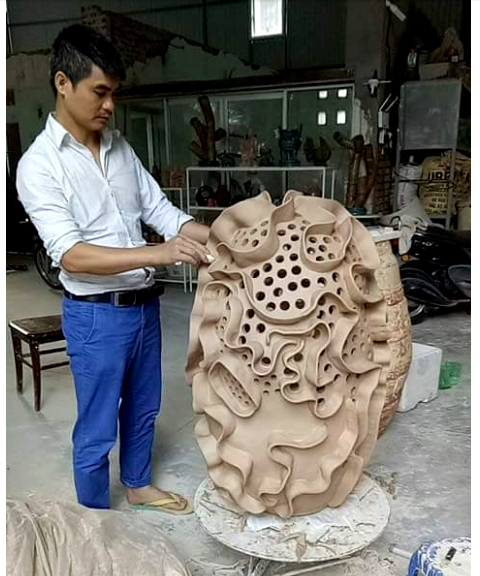
Artisan Nguyễn Hồng Tân and his latest ceramic art work inspired by carambola.
(Photo credited by Gom Chi)
|
Somebody once compared Chi ceramic products to rural girls – they are simple, plain, but piquant. They are not overwhelming or glossy, but they can stir customers’ hearts. The glaze applied to the surface is uneven. In some places it is thick, in other places thin; some places are bare but there may be extra drops somewhere else.
Tân says: “It requires many types of materials to turn out our traditional fluid melt glazes. It’s possible to use various kinds of stones, ash, and rice husks. Of course, we have family secrets, especially in applying glazes.”

Chi ceramics’ Hoang Luu Ly enameled tiles (Photo: Bao Tram)
|
In the late 1960s, artisan Nguyễn Văn Chi quit his work at the Hải Phòng Porcelain Factory to move to Hà Nội and open a workshop specializing in ceramic decorations.
In 1970 he built the first private coal kiln at 68 Nguyễn Du Street to make flower jars and vases for Tet decorations. He dried unfired products on the corner of Nguyễn Du Street.
This became a familiar sight in the neighborhood. The phrase “Chi lọ” (Chi vase) became a household word among artists and ceramic lovers in Hanoi.
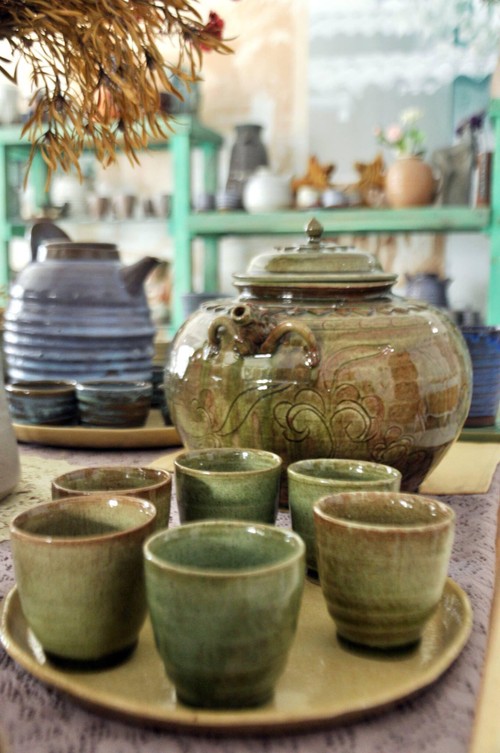
The most basic products like dinnerware and teapots are created manually.
(Photo credited by Gom Chi)
|
His most successful period was between 1989 and 2000 when he and his sons participated in the restoration of the Hue Citadel, reproducing Thanh Lưu Ly and Hoàng Lưu Ly enameled tiles. Mr. Chi was invited to Hue to do the restoration because no workshop in Hue remembered how to make Lưu Ly tiles.
First my father successfully reproduced the Bát Tràng bricks mentioned in ancient folk verses. Then in 1988 the Hanoi Flag Tower and its yards were paved with the Bát Tràng bricks he made.
Although Bát Tràng bricks were originally created by Bát Tràng locals, the techniques had been lost. The locals tried for more than two years to recreate the original product, but they failed.”
Since 2000 Chi ceramics have been widely popular in Hanoi, having been selected that year for display at a Vietnamese-Japanese ceramics exhibition as part of a cultural exchange between the two countries.
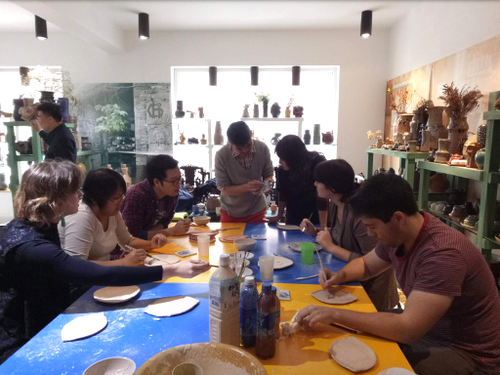
Chi ceramics workshops attract many foreigners. (Photo credited by Gom Chi)
|
Mr. Chi’s workshop has created jobs for many people, such as Nguyễn Văn Thư of Bắc Giang province, who has been involved in the craft for more than a decade.
“At first, everything was new to me. I began to realize that perhaps fate clings to Chi ceramics. Each product has unique characteristics. Graphics and glaze are two of the characteristics that identify Chi ceramic products. Because they are handcrafted, they are all different,” Thư recalled.
In today’s fiercely competitive society, traditional handicraft families treasure their craft and try continually to improve and diversify the design of their products. Offering hands-on workshops is a trendy and effective way to publicize a brand. Chi ceramics offers workshops every second Saturday.
 Jade Thomas Jade Thomas |
Jade Thomas, a 24-year-old Australian student who has been in Vietnam for 4 years, learned about Chi ceramics when their workshop and retail sales store popped up on her Facebook feed. When she saw that they offered a full Saturday afternoon of learning how to throw and shape clay on a wheel, Jade decided she had to get involved.
She shared her memory of that day: “The thing I liked most about Nha Gom Chi was the feeling of being welcome, and the gentle nature of the teachers. They helped me feel confident and comfortable to learn the pottery process and it allowed my creativity to be unleashed. “
In addition, Jade said she found “the steps hardest during the ‘throwing’ process was learning how to use the manual when and spin it myself. It was difficult to maintain a steady speed and concentrate on shaping the clay. It took a lot of concentration.”

A corner of Chi Ceramics Workshop in Yen Vien (Photo credited by Gom Chi)
|
An anonymous customer shared his thoughts about Chi ceramics: “Most people have the same thought when they see Chi ceramic products for the first time: they aren’t beautiful. But when you continue to look, you get bewitched and feel the deeper beauty. The more you look, the more beauty you can find in Chi ceramic products.”
For artisan Tân and his younger brother, Nguyễn Tân Hồng, the most important thing is this: “We’ll carry on the family craft until we can’t do it anymore. We don’t have any big plans, but we have dreams.”